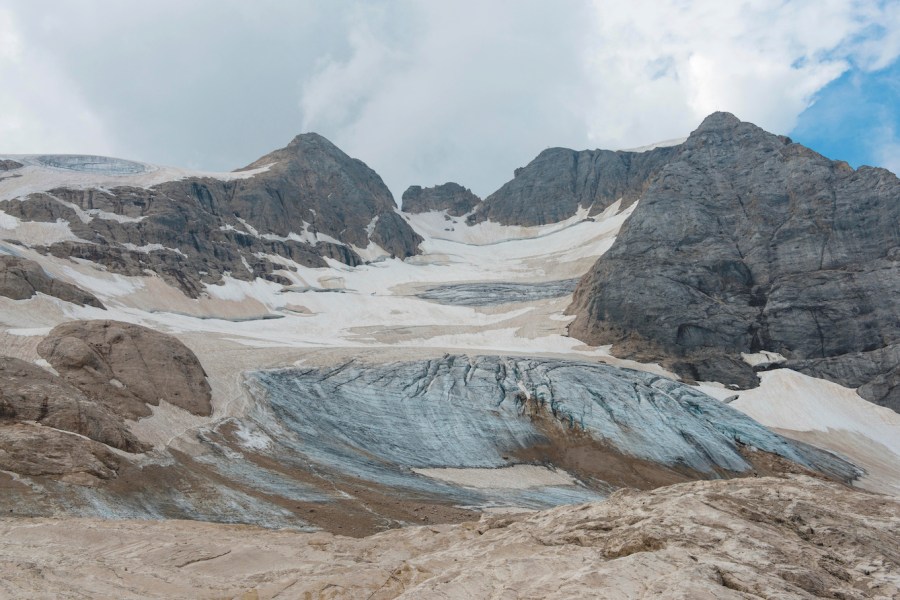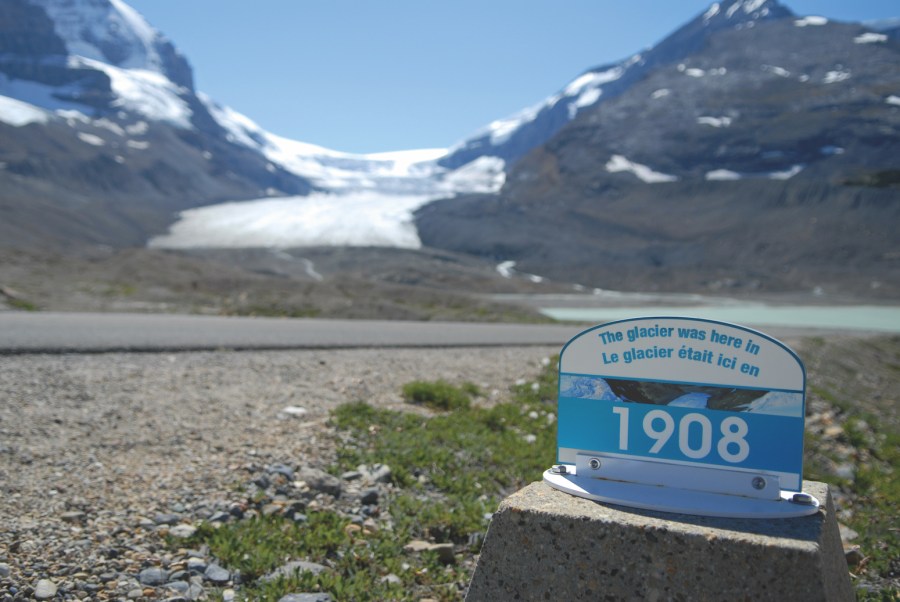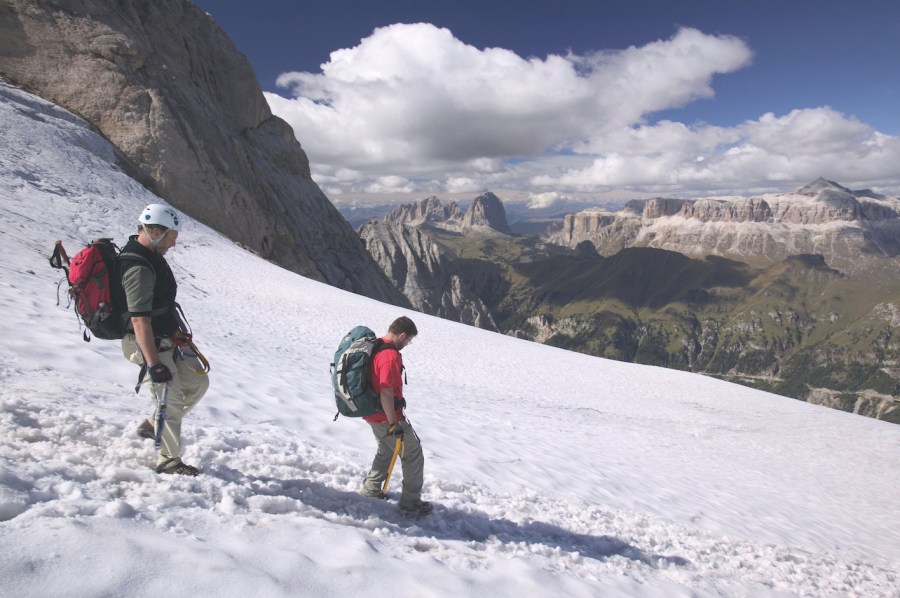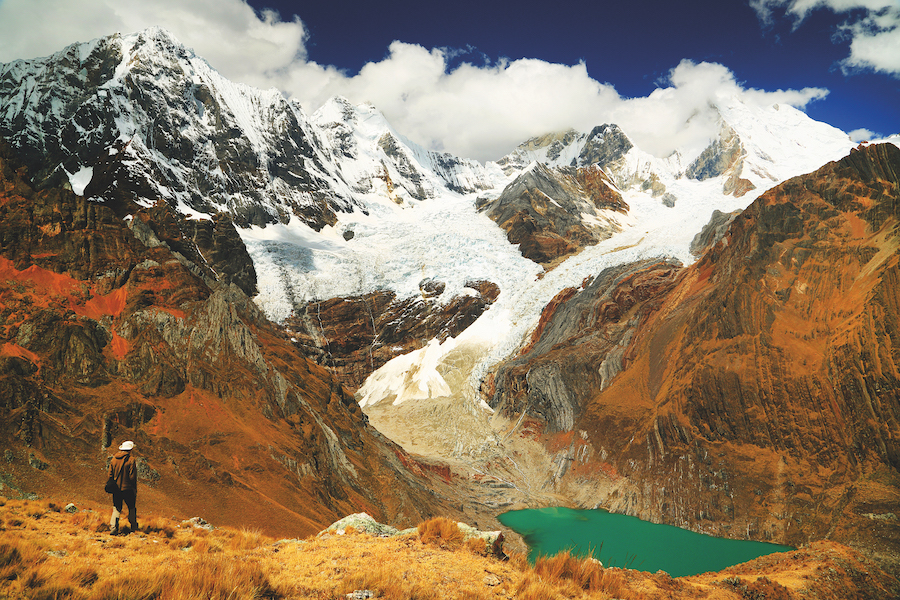Soaring temperatures in the high mountains are causing glacier collapses, rockfalls and route closures. Hanna Lindon looks at how climate change is changing mountaineering.
Main image: a retreating glacier in Peru’s Cordillera Huayhuash. Photo: Shutterstock
For some time now, mountaineers have been sounding the alarm about the threat of climate change to those who walk and climb in the high mountains. And this summer, the effects of warming temperatures have become increasingly – and tragically – clear.
Earlier this month, the Dolomites witnessed the most serious climate-linked mountaineering accident in recent years. Eleven people were killed when a glacier on the 3300m-high Marmolada collapsed during an early summer heatwave. It followed close on the heels of a winter drought with very little snowfall.
“Combined with unusually high temperatures across the region over the summer, glaciers are melting fast,” explained Professor Jonathan Bamber, Director of the Bristol Glaciology Centre at the University of Bristol. “That section that broke off was part of a hanging glacier with seracs or ice cliffs that become particularly unstable during warm conditions.”
In recent years, serious rock falls have become more common in the Alps as permafrost melts; collapsing rock faces have destroyed famous Alpine climbs such as the Lepiney and Les Untouchables, and 93 of the routes in Gaston Rebuffat’s classic book Mont Blanc Massif: The 100 Finest Routes have been affected by climate change.
The Marmolada tragedy was just one consequence of a heatwave which has disrupted mountaineering across the Alps this summer. Last week, Alpine mountain guide associations decided to stop guiding clients on classic routes in a host of regions, including Chamonix, Courmayeur, Cervinia, Lauterbrunne and Grindelwald. And today, another heat record was broken in the Alps, as the freezing point above Switzerland rose to 5,184 metres.
First high-alpine #rockfall events are appearing, most likely due to the strong warming of #permafrost at altitude. This one is from yesterday afternoon on the Italian ridge of the #Matterhorn just up from the Carrel hut. #ClimateEmergency #ClimateBreakdown pic.twitter.com/ZmprYYU1uz
— Jan Beutel (@jan_beutel) July 22, 2022
‘Directly linked to climate change’
Professor Poul Christoffersen of the University of Cambridge says that the Marmolada incident was directly linked to climate change. “High elevation glaciers such as the Marmolada are often steep and relying on cold temperatures below zero degrees Celsius to keep them stable,” he explained. “But climate change means more and more meltwater, which releases heat that warms up the ice if the water re-freezes, or even worse: lifting the glacier from the rock below and causing a sudden unstable collapse.”
Of all the indicators of climate change see in the mountains, melting glaciers have been the most visible. In 2012, Chamonix authorities were forced to construct a 60m Himalayan-style suspension bridge to the Conscrits hut after a receding glacier made access too dangerous. A new trail, complete with fixed ladders, was recently built to the Charpoua hut for the same reason.

The Marmolada glacier before the July 2022 collapse. Photo: Shutterstock
“Glacier decline has been accelerating across the Alps over the last few decades, due to global heating making the high mountains of Europe an increasingly dangerous and unpredictable environment to be in,” said Professor Bamber.
A global issue
The problem goes far beyond the Alps. Just two days after the Fassa Valley held a day of mourning to commemorate those killed in the Marmolada avalanche, video footage emerged of another dramatic glacier collapse in Kyrgyzstan. The group of hikers involved in that incident were lucky: there were no deaths and only one minor injury. But it was another example of the increased dangers to hikers and mountaineers posed by our changing climate.
“We know that a general trend of warming and more extreme temperatures in high mountain areas destabilise slopes,” says Dr Scott Watson, COMET Research Fellow in Earth Observation and Geoinformatics at the University of Leeds. “More extreme precipitation events in a changing climate can also play a role. Globally, as glacier cover decreases and permafrost thaws, the conditions are created for large ice detachments [such as] Marmolada or events incorporating a mix of ice and bedrock [such as] the Chamoli event last year.”
Mountaineer and University of Leicester scientist Dr Suzanne Imber told The Great Outdoors that she’s seen stark examples of receding glaciers as far afield as the Andes. “I wish I could show you photos taken of the Andes a decade apart. We tend to use the same access routes into the mountains, and the pictures of those environments really show the change. There was one mountain in Argentina where a glaciology project had previously been. We found detritus left over from the project – all this equipment sat in what looked like a high-altitude desert. The point was that the glacier had gone. Seeing it first-hand like that really brought it home.”
And Dr Watson says that climate change is also beginning to affect climbers and mountaineers in the world’s highest mountain range – the Himalayas. “Rockfalls are increasingly common in the Alps, particularly following heatwaves; and a similar trend is expected in the Himalayas.

A marker showing the extent of glacial retreat in Jasper National Park, Canada. Photo: Shutterstock
“The Himalayas are at a less advanced (though accelerating) stage of deglaciation and there are fewer people in direct contact with the mountains, so we only hear about the most damaging events; there will be thousands more under the radar. As more people inhabit or visit these regions the risk increases.
“Climbers are often the most exposed, but there will be areas where trekking routes are affected by landslides and rockfalls, and we’ve also seen cases of floods caused by glacial meltwater washing away trail bridges.”
Danger season
Short of staying out of the high mountains completely, the dangers posed by melting glaciers and landslides can’t be completely avoided. However, there are specific times of the year when mountaineering is destined to become more perilous. ‘Melt season’, which occurs during the warmer months and increased significantly in length between 2000 and 2019 in the Alps, is often when collapses occur.
“[The Marmolada event] is what’s known as an ‘ice fall’, where the glacier flows from a stable, flattish upland topography (a corrie or cirque) onto steeper topography,” explains Professor Martin Siegert, Co-Director of the Grantham Institute at Imperial College London. “Here, calving can occur and the system can become unstable. That stability is affected by melting, and as we’re well within the melt season now it’s unfortunately not a surprise that glaciers like this may collapse across their steep section.
“Italy, Switzerland, Austria, France and Germany have a glacier monitoring programme where the state of many glaciers is assessed. As a glaciologist I would avoid proximity to an ice fall in the melt season.”

Climbers descending the Marmolada glacier. Photo: Shutterstock
Britain’s mountains are also likely to be impacted by rising temperatures. According to Professor Piers Forster, Director of the Priestly International Centre for Climate at the University of Leeds, unchecked climate change could have serious consequences for UK mountain ranges. “As we are seeing in the Alps, crumbling glaciers and thawing ground can become a real safety concern for walkers and residents with an increased threat of landslides,” he says. “This, coupled to more powerful storms with more rain and stronger wind, will make winter activities more dangerous.”







